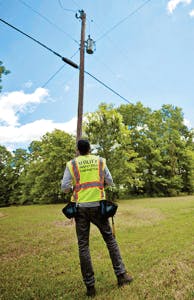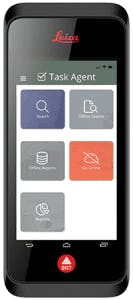Feeling Attached But Overloaded?
5G deployment is unique. To begin, 5G requires small cells — and lots of them. The Small Cell Forum (SCF) forecasts the worldwide Small Cell Market will continue to grow at a compound annual growth rate of 13% between 2019 and 2026.
To meet the market demand, telecom providers and their joint use partners cannot afford any speed bumps that might slow down deployment. That’s why they must be aware of recently passed legislation from the FCC. In addition, they need to understand how these 5 things impact the small cell attachment process:
1. Power Supply
Small cell attachments are low-power; however, they do require a power source, making them different than other types of equipment.
2. Backhaul Requirements
Fiber backhaul solutions must transport data from the field to operator’s network.
3. Antenna Placement
Usually a small cell attachment is placed on top of a utility pole. If that space is taken by an existing service provider, the new provider has to find another location or pole.
4. Asset Structural Integrity
Before adding a small cell attachment, engineers are required to assess structural integrity. They should inspect safe weight loading capacity, how much added wind-force the antenna will contribute, and (for strand mounts) the weight-loading impact of internal or external cabling.
5. Permitting and Approvals
5G architecture presents different deployment challenges than previous equipment. Therefore, joint use stakeholders must effectively communicate with one another to streamline small cell attachment permitting.
InvisiLight® Solution for Deploying Fiber
April 2, 2022Go to Market Faster. Speed up Network Deployment
April 2, 2022Episode 10: Fiber Optic Closure Specs Explained…
April 1, 2022Food for Thought from Our 2022 ICT Visionaries
April 1, 2022Is It a Fit?
Each utility pole, in a sense, tells its own story. The data collected about each pole includes:
• Who owns it.
• What it’s made of.
• Its capacity.
• Which companies have attached equipment and lines to it.
• Who approves each attachment.
• Whether each existing (and new) attachment is up to code.
• Additionally, each pole has its own dimensions, surrounding environment, and structural capabilities.
Gathering and documenting all of that information about each individual pole is necessary for changes and new installations. Unfortunately, documenting utility pole data with traditional methods is prone to inaccuracies, and has historically required multiple trips to the field. In other words, the old ways of doing business are simply not efficient or scalable.
Let’s examine the process in detail.
• A service provider planning to attach equipment to a utility pole must first file a permit to attach request with the pole owner.
• Then, the pole needs to be reviewed and measured to make sure there’s space for the attachment.
• Documentation must prove that that the pole can handle the structural load, and that other existing attachments are up to code.
If space needs to be made for the new attachment, make-ready work is required and involves additional parties. That level of collaboration requires communication based on accurate, up-to-date data for each utility pole or other asset in order for the work to be successful.
For companies to determine whether a utility pole is a good fit for a small cell attachment, they need accurate and updated data for each pole, including, but not limited to, the following:
• Who owns the asset
• Asset type
• Asset height
• Location
• Material
• Number of existing attachments
• Power availability
Traditionally, field technicians used a hot stick to collect much of this data, and many still do. It’s a fiberglass measurement tool that can be raised and lowered to measure a pole and attachments. This method works well in many cases, but it can lead to different interpretations of the data and also to costly field revisits if information needed isn’t captured during the first trip.
New Solutions
There are new solutions to collect measurement data that leave no room for human error.
Technician captures utility pole data in field.
In our mobile world, handheld tools that can take photos and measure the objects and structures in the image have helped to simplify data collection. Coupled with an app that allows field techs to input dimensional data in real time for each utility pole they measure, these tools capture all relevant data, which is then sent to engineering teams or shared with other project stakeholders.
Having a standardized process to collect data for field assets ensures network service providers, pole and structure owners, or state regulatory agencies in charge of utilities, have real-time access to accurate dimensional data.
It’s not hard to see how streamlining data collection can, effectively, accelerate 5G rollout.
There’s even more good news. Vendors serving the asset management community are evolving their solutions to meet the need for swift accurate data collection. One such solution is a handheld tool, BLK3D from Leica Geosystems, part of Hexagon. Using the Alden One platform with this handheld imager provides a unified data set of all assets, components and characteristics to support a 5G deployment.
Data Overload
The complexity of collaboration surrounding small cell attachments doesn’t stop with data collection — managing them is the real trick.
Many service providers and/or contractors are managing the data with spreadsheets, though that’s not the most efficient or effective when dealing with large amounts of data. A better option is a joint use platform that allows telecom providers and their contracting partners to streamline the mounds and mounds of data they deal with daily.
Field tech using BLK3D to capture pole measurements.
Here are a few ways that a centralized platform that provides one source of truth helps to eliminate the hours wasted in the "spreadsheet shuffle." It helps users to:
1. Consolidate many elements of asset data in an accessible format that is used for both deployments and maintenance:
• Pole information
• Vault information
• Attachment permitting documents
• Small cell and DAS location, size, and type
• Fiber information
• Streetlight location and size
• Tower location and size
• Pole transfer information
• Pole and vault inspection records
• Billing and invoicing records
• New and renewing contract information
2. Securely share data with internal defined users or external stakeholders.
3. Integrate asset data with other internal groups by creating rules to automatically transmit asset data to enterprise applications, such as a geographic information system (GIS), a work management
system (WMS), or a financial information system (FIS), to ensure engineering, operations, and finance, are operating smoothly.
4. Create workflows from daily procedures to automate business processes and ensure consistent data quality.
Daunting, or Not So Much?
Alden’s Task Agent app running on BLK3D handheld imager.
Another significant challenge to asset managers is that utility pole data isn’t a standard set of data. The specific attributes needed changes from project-to-project and from pole-to-pole. With a platform, telecom and service providers, pole owners, and other stakeholders, can manage the variability of the data set. When the software is configurable for each user or company, workflows can be accelerated.
For instance, let’s examine a few scenarios. If a field tech documents a pole and finds there is enough space for an attachment, then he or she can move forward and attach once approved.
But if there isn’t enough space, a whole different set of data must go into a field data collection tool like Alden’s Task Agent app. All the data that gets collected for each pole may need to be modified during a project. Having a platform means that all this data is uniform and useful for each stakeholder.
Clearly, no 2 deployments of 5G are identical. But, when all of the processes, roles, and work, are structured and centralized in a web-based platform, the various stakeholders can work in harmony.
By facilitating that kind of effective information sharing, we can all realize a 5G deployment that is far swifter and more efficient. And that takes a load off us all.
Resources and Notes
For more information about the Small Cell Forum forecast, Small cells market status report July 2020, visit https://scf.io/en/documents/050_-_Small_cells_market_status_report_July_2020.php
https://shop.leica-geosystems.com/learn/reality-capture/blk3d
https://www.aldensys.com/aldenone
For more information, please email [email protected] or visit https://www.aldensys.com/.
Follow us on Twitter @aldensystems.







